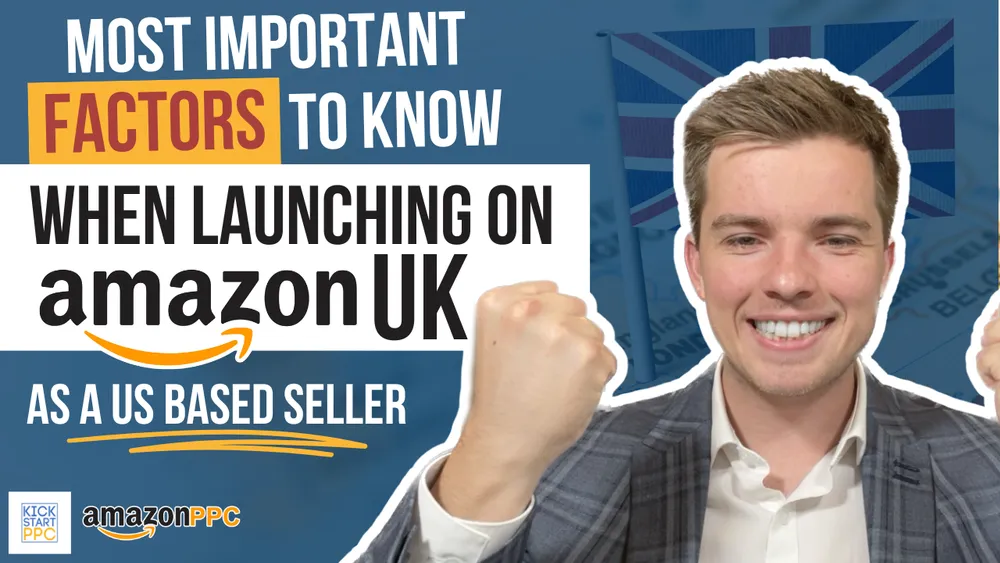
Most Important Factors to know when Launching on Amazon UK as a US Based Seller
Expanding your business beyond the U.S. can open up new opportunities for growth and revenue. Many brands typically set up shop in the U.S. due to its large market size and higher keyword volumes. However, they often overlook the potential in other markets, such as the UK. Here’s why U.S.-based sellers should consider launching on Amazon UK.
Market Potential in the UK
The U.S. market is attractive because of its sheer size, with over 300 million people, offering vast opportunities to scale. However, this focus on the U.S. means many brands don't look beyond its borders. While some may expand to Canada or Europe, many miss out on the potential of the UK market.
Despite its smaller size—roughly equivalent to the combined populations of California and Texas—the UK offers significant opportunities. The UK’s e-commerce infrastructure is robust, with efficient logistics enabling one-day shipping across the country. This makes it an excellent market for brands looking to expand.
Lower Competition and CPC
One significant advantage of the UK market is the lower competition, which translates into lower Cost-Per-Click (CPC) rates. Lower CPC means you can achieve higher visibility with a smaller budget compared to the U.S. This provides an excellent opportunity to capture top search placements and increase your market share with less financial strain.
Successful Case Studies
Brands that have ventured into the UK market often find success. For example, a brand with fewer than ten products can generate substantial revenue through PPC alone, without accounting for organic sales. This success isn’t isolated; numerous brands perform well in the UK across various industries. The lower CPC and the market’s efficiency contribute to this success, making the UK a lucrative option for expansion.

Adapting to the UK Market
Expanding to the UK isn't as simple as replicating your U.S. strategy. While the UK market offers potential, you need to adapt your approach to fit local preferences and regulations.
Market Research: Utilize tools like Amazon's Marketplace Product Guide to analyze the UK market. Look at category insights to understand sales volumes, competitive pricing, and keyword performance in the UK.
VAT Considerations: In the UK, Value-Added Tax (VAT) is included in the sales price, unlike in the U.S. where it's added on top. Ensure your pricing strategies account for VAT to avoid unexpected costs.
Localized Listings: Adapt your product listings to suit the UK market. Language differences mean certain terms and marketing messages that work in the U.S. might not resonate in the UK. Tailor your listings to reflect local terminology and preferences.Bidding on Placements
Understanding where your ads will appear is crucial for maximizing visibility and conversions. There are three main types of placements:
Top of Search: Ads placed here tend to have the highest conversion rates.
Rest of Search: These are ads that appear further down the search results page.
Product Pages: Ads on product pages appear alongside other products and are often more effective for competitive pricing strategies.
To ensure your ads appear in the most valuable positions, consider increasing your bid multipliers for top-of-search placements.
Campaign Naming and Organization
Organizing your campaigns effectively is vital for tracking and optimizing performance. The video suggests a detailed naming convention that includes the product name, ad type, match type, and other relevant details. This structure makes it easy to identify and manage your campaigns, particularly as your advertising efforts scale.

Seasonal Variations
The UK’s weather is relatively uniform across the country, unlike the U.S. where it varies significantly by region. This affects the seasonality of certain products. For instance, summer-related products may not perform as well during rainy periods. Conversely, winter products might have limited appeal outside of regions like Scotland.
Understanding these seasonal trends is crucial for inventory and marketing strategies. Analyze sales data to identify peak times for different products and plan accordingly.

Practical Steps for Launching in the UK
Category Insights: Start by examining category insights to gauge market potential. For instance, in the Beauty and Personal Care category, compare sales volumes between the U.S. and the UK. While the UK market may be smaller, the lower competition can lead to better returns.
Competitive Pricing: Evaluate pricing strategies in the UK. While UK consumers may be less willing to pay high prices compared to U.S. consumers, the lower CPC can offset this difference.
Keyword Strategy: Focus on broader keywords in the UK due to lower search volumes. Use tools like Helium 10 to analyze bidding structures and identify cost-effective keywords.
Conclusion
Launching on Amazon UK offers a promising avenue for U.S.-based sellers looking to expand their reach. The lower competition and CPC, coupled with efficient logistics, make the UK an attractive market. However, success requires thorough research, understanding local nuances, and adapting strategies to fit the UK market.
If you need assistance with launching in the UK or managing your Amazon PPC campaigns, consider reaching out to professional services like Kickstart PPC. We can help you navigate the complexities of the UK market and set your brand up for success.
Stay tuned for more insights on Amazon PPC and FBA content by subscribing to our channel. We release new content regularly to help you stay ahead in the e-commerce game.
If you are looking for help with your Amazon PPC book a discovery call and free PPC Audit HERE
